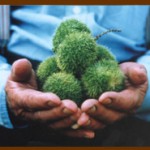Re-Introduction of the American Chestnut
Re-Introduction of the American Chestnut
Fall 2010 – Spring 2011
Bill Minter, Asst. Prof. of Environmental Science and Director of Land Management at Merry Lea, is into his tenth year cooperating on a joint project with the American Chestnut Foundation and Purdue University’s Hardwood Tree Improvement Center. American chestnut, a native tree commonly found in the Eastern Deciduous Forest at the beginning of the 20th Century, was virtually exterminated by the early 1950’s. Its demise resulted from blight disease accidentally introduced from northern China.
In 2001 approximately 200 seeds, representing 4 families of previously crossbred American chestnut x Chinese chestnut, were planted at Merry Lea. They contained 7/8ths of American chestnut’s genetic material, yet the blight resistance of Chinese chestnut. In 2009 the trees were inoculated with chestnut blight and further evaluated for resistance to infection. Three individuals were later identified for their high resistance and, in spring 2010, their female flowers were isolated and fertilized with pollen from American chestnut parents to develop progeny with 15/16ths of the American chestnut’s genetic material.
In fall 2010, nuts from these fourth backcrossed (BC4) trees were collected. They were planted in a seed orchard on public land in northern Indiana, along with seeds from Purdue University. Prior to public release of these blight-resistant chestnuts, some of the seedlings from the BC4 parents will be planted at Merry Lea on their blight-infected site of origin. Further evaluation will be done on this experimental planting in the spring and summer to confirm how well the blight resistant trait is exhibited among all of these individuals with the same ancestry.
(All images from the American Chestnut Foundation – www.acf.org)





